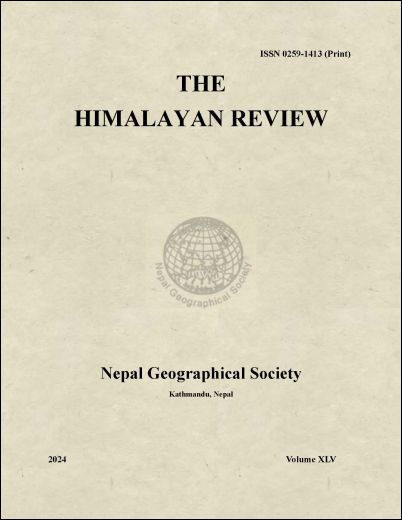Evaluating Lakes Boundary Change: A Case Study from Ward Number 26 of Pokhara Metropolitan City
DOI:
https://doi.org/10.3126/hr.v45i1.68170Keywords:
Land and Use Land Cover (LULC), Normalized Difference Water Index (NDWI), Normalized Difference Vegetation Index (NDVI), Remote Sensing, Cadastral MappingAbstract
Lakes are crucial for their multi-faceted services, including drinking water, irrigation, tourism, and more. Understanding their status, including area coverage, is important, and continuous monitoring is essential. Lakes can be monitored through various approaches, ranging from traditional ground-based surveys to advanced earth observation satellites. This study aimed to monitor several lakes in Ward Number 26 of Pokhara Metropolitan City, including Khaste, Neurini, and Gunde Lakes, using high-resolution cadastral maps, ground-based field surveys, and Sentinel-2 earth observation satellites. Additionally, focus group discussions and key informant interviews were conducted. Supervised land use and land cover classification and the Normalized Difference Water Index method were employed to determine the area of each lake in 2017 and 2021. The focus group discussions and key informant interviews investigated factors affecting lake dynamics. The study found that climate change, land use change, floods, water abstraction, and landslides are major factors contributing to changes in lake areas. The results showed that the satellite-derived lake boundaries were smaller than those indicated on the cadastral map. Ground surveys using total station equipment also revealed that Khaste Lake shrunk by 6122.73 m² (0.01 km²), Neurini Lake lost 474.95 m² (0.00005 km²), and Gunde Lake shrunk by 4226 m² (0.004 km²) due to encroachment. Although satellite images are useful for detecting large-scale changes, this study indicates that the lake boundary areas identified through satellite imagery were smaller than those delineated by cadastral maps and ground surveys. This suggests that remote sensing analysis alone is insufficient for studying small lake boundary changes and should be combined with ground-based surveys. Therefore, a combination of satellite images and ground-based surveys is recommended for accurately and comprehensively detecting changes in lake areas.




